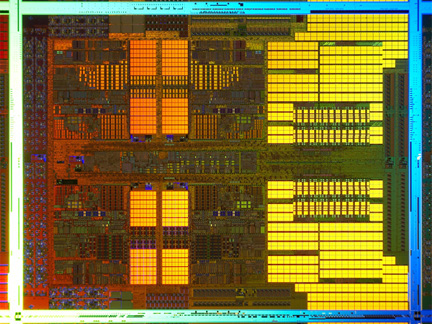AMD launches 45nm 'Shanghai' processor

AMD launched its latest quad-core Opteron processor, code-named 'Shanghai', on Thursday.
The chipmaker hopes that the improved performance and energy efficiency of its first 45nm (nanometre) server processor will help re-establish the company's competitiveness, following problems and delays with the previous-generation, 65nm Barcelona chip.
In a marked change from its previous processor launches, AMD chose to put more emphasis on improved power consumption than faster performance. However, raw performance is improved through 6MB of L3 cache, up from 2MB on its 65nm predecessor, and a clock range from 2.3GHz to 2.7GHz, up from 2.0GHz to 2.54GHz, while the chip's power envelope stays the same as Barcelona, at under 100W.
"This is the best processor ever in terms of cost, performance and energy consumption", said Emilio Ghilardi, general manager for AMD EMEA at a press conference on Wednesday.
"It is not just about performance anymore," said Ghilardi. "It is performance per watt, per dollar."
Along with the increasing emphasis placed by the IT market on energy efficiency, another issue is migration — moving from older or less-efficient systems to newer ones. At the launch, AMD demonstrated 'live migration', upgrading individual system units while they are installed with older working systems.
"Customers know that now is not the time for costly upgrades," said Leslie Sobon, AMD vice president of marketing. "Customers want easy and fast migration." The company demonstrated live migration between AMD and Intel systems, and also showed two systems, one with Opteron and one with Shanghai, working on the same rack. After a Bios update, existing Barcelona boards can take Shanghai chips, although the enhanced HyperTransport 3.0 bus, described as an "upcoming enhancement", running at 17.6Gbps will only run at HyperTransport 1.0 speed of 8.0Gbps until the availability of new chips in the second quarter of 2009.
"It is a quick and seamless migration [path]," said Sobon.
The overall power savings were "35 percent power saving at idle, and between 15 and 20 percent when working and all at the same frequency", according to Sobon. The company said that it expects to gain advantages over the competition from its superior hardware-assisted virtualisation, including faster switching between virtual machines and better performance from its on-board memory controller. Another power-saving feature is Smart Fetch, more complex cache management whereby the contents of each core's L1 and L2 cache are copied to the shared L3, allowing the cores to halt.
The launch of the new processor came soon after the company announced its second round of job cuts, affecting 500 workers. That news itself followed the announcement in April that AMD was cutting 1,500 jobs.
At the launch, Ghilardi made no mention of the job cuts but did admit to some issues with producing Shanghai. "We have had difficulties with new processors before," he said. "But, if you look at Shanghai today, it is a damn good product; much better than we had heard from the media perception of the product."
Chips for two-socket boards are priced from $377 (£254) to $989, and four- or eight-socket parts are priced from $1,165 to $2,149. Single-socket parts are expected early in 2009.
